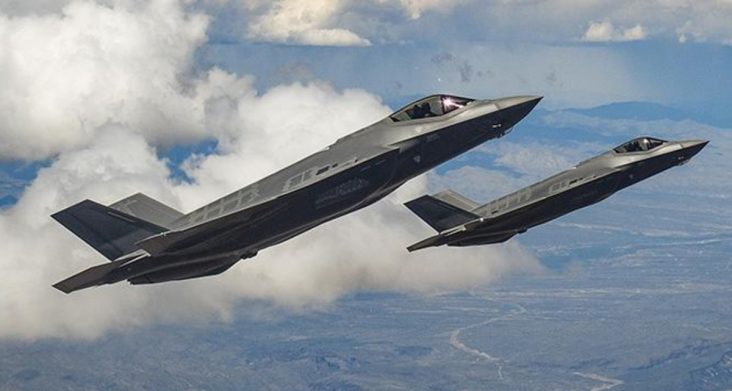188th officials ‘laser-focused’ on new mission; Michigan senators’ objections not likely to reverse decision
by June 7, 2021 11:43 am 2,167 views

The F-35
Decisions about facility renovation, new construction and other practical matters are part of the process for the U.S. Air Force pilot training center coming to Fort Smith, and objections to the decision are not likely to change a final decision set for spring 2023.
The acting Secretary of the Air Force John Roth selected Ebbing Air National Guard Base in Fort Smith to be the long-term pilot training center supporting F-16 and F-35 fighter planes purchased by Singapore, Switzerland and other countries participating in the Foreign Military Sales (FMS) program.
Officials announced the selection process on July 20, 2020. The Defense Security Cooperation Agency, the federal agency managing the FMS, notes that the program provides “responsible arms sales to further national security and foreign policy objectives by strengthening bilateral defense relations, supporting coalition building, and enhancing interoperability between U.S. forces and militaries of friends and allies.”
Up to 36 aircraft will be part of the center, with F-16’s of the Republic of Singapore 425th Fighter Squadron set to arrive in 2023 and the advanced F-35’s to come in 2026. According to Roth, a final basing decision will follow an environmental impact study and be announced in spring 2023.
OBJECTION TO EBBING
U.S. Sens. Debbie Stabenow, D-Mich., and Gary Peters, D-Mich., did not receive the June 3 announcement well. Situated just north of Detroit, Selfridge Air National Guard Base was selected as the alternate site if Ebbing fails an environmental impact analysis. Sens. Stabenow and Peters said Selfridge should have been the first choice and promised to raise questions about the decision.
“I strongly disagree with the Air Force’s decision,” Stabenow said according to the Macomb Daily. “Selfridge has the personnel, the airspace and the facilities, and was the most cost-effective choice to host these F-35 training missions. Selfridge was already evaluated by the Air Force as a location that could support the F-35 in a previous basing. Bottom line – this decision simply does not add up. I will be demanding answers to a number of questions as to how this decision was made by the Acting Air Force Secretary.”
“There are many important, unanswered questions about how and why the Air Force made this decision. I have repeatedly pressed for a decision based on fairness and merits, and I’m demanding answers and full transparency from the Air Force and Biden administration about why Selfridge Air National Guard Base was not chosen,” Peters said in his statement about the decision. “There is no question that Selfridge stood out as the clear choice to host a new training mission because of its facilities, capabilities and assets for our national security, and I question the conclusion that the Air Force reached. It’s critical they explain all the factors that went into this decision.”
A statement from the office of U.S. Rep. Steve Womack, R-Rogers, whose district includes the Fort Smith area, suggests the decision is not likely to be reversed.
“This is not like a federal contract. There is no formal challenge process. The Air Force uses what they call the ‘Strategic Basing Process’ to make basing decisions – this is a repeatable, transparent process to ensure fairness,” noted the statement from Womack’s office. “Some other delegations and states are voicing opposition, and there is no reason to believe anything will come of it. The Air Force’s Strategic Basing Process is transparent and repeatable.”
FACILITY, PERSONNEL QUESTIONS
According to Womack’s office, the process includes an estimated up-front preparation cost of $24 million to be paid for by the foreign partners. Womack’s office said Ebbing “had the lowest up-front cost estimate due to the 188th commitment to providing and repurposing existing facilities – they made a huge difference with their innovation and problem-solving.”
Col. Leon Dodroe, commander of the 188th Wing, said decisions about facilities and personnel are part of the “what’s next” process. Much of the infrastructure used at Ebbing when its mission included F-16’s and A-10’s is still in place and can be used for the pilot training center, according to the 188th.
“There are a multitude of factors and courses of action in play. We expect follow-up on site visits to determine the preferred course of action. It is expected that some buildings will be used as is, some will require renovation, and some will be new,” Dodroe told Talk Business & Politics when asked about facilities.
Dodroe said the pilot training center would be part of the existing Ebbing footprint, with new gates or a separate base-within-a-base not part of the plant. He said the command structure for the new pilot training center would include various parties.
“It will be a combination of command channels primarily through the 188th Wing. Singapore will play a part, active association will play a part, and we will have some command and oversight,” he said.
The pilot training center is estimated to bring to Fort Smith 345 U.S. military personnel and 180-plus members of the Singapore unit and around 300 dependents. When they arrive and in what phases remains unknown. Dodroe says there are “just too many variables” to know when additional U.S. military members would arrive.
“Some will arrive before the planes, but most will be concurrently over time. It is our estimate that a smaller initial footprint of personnel will start arriving in the summer of 2022,” Dodroe said about members of the Singapore unit and their families.
Dodroe said they are eager to learn about other actions required to establish the pilot training center.
“This is a big deal, and we are excited to figure that out,” Dodroe said when asked about other “what’s next” items. “Currently, we are laser-focused on the site activation team coming in a few weeks.”
